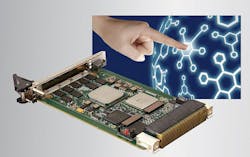U.S. Air Force evaluates COTS solutions for next-generation airborne radar
ASHBURN, Va., 8 March 2016. U.S. Air Force officials are leading the Next Generation Radar (NGR) Processor Study to assess the ability of commercial off-the-shelf (COTS) hardware and software to perform airborne radar signal processing functions.
Officials at Curtiss-Wright’s Defense Solutions division in Ashburn, Virginia, participated in the study, demonstrating its multiprocessor High-Performance Embedded Computing (HPEC) radar processing architecture. The company’s proposed HPEC radar processing solution, based on the Air Force’s demanding specifications and requirements, met the study’s target benchmarks, officials say.
Curtiss-Wright ran and optimized the study’s Synthetic Aperture Radar (SAR) and Ground Moving Target Indicator (GMTI) benchmarks on a solution that includes the company’s newly introduced OpenHPEC Accelerator Suite development tools, five OpenVPX DSP modules, and a 40 Gbps OpenVPX Ethernet switch module. During the study, Curtiss-Wright tested current-generation and next-generation OpenVPX modules.
"We are very pleased to be able to announce that our HPEC Radar system architecture, along with our OpenHPEC suite of development tools, provides the performance and survivability needed to meet the Air Force’s demanding radar processing requirements with cost-effective COTS technology," says Lynn Bamford, senior vice president and general manager, Defense Solutions division. "We have successfully demonstrated how our cost-effective open architecture DSP and network switch building blocks, along with our industry-leading, open standard-based OpenHPEC Accelerator Suite of software tools can be effectively used to design whole new classes of rugged deployed HPEC solutions that deliver all of the proven cost savings and long lifecycle benefits of COTS technology while elevating radar processing performance to levels never before achievable."
The benchmarks are designed to leverage advances in commercial high-performance computing (HPC) software, such as OpenCL, VSIPL, FFTW, and MPI, for compute-intensive defense and aerospace applications. The test results (available to customers by writing [email protected]) showed that standard conduction-cooled OpenVPX modules, such as Curtiss-Wright’s Intel Xeon processor D-based CHAMP-XD2 DSP module, can be used to satisfy the performance requirements to support the SAR and GMTI benchmarks in the most demanding Air Force environments.
Curtiss-Wright benchmarked and optimized its HPEC-based radar processing system design based on its Fabric40 rugged OpenVPX board and chassis products. Fabric40 products deliver the industry's first complete end-to-end system approach for integrating 40 Gbps high-speed fabrics into aerospace and defense HPEC applications. Curtiss-Wright Fabric40 system elements provide a complete system solution, including single board computers (SBC), DSP, and FPGA engines, GPU processors, network switches. and backplanes.
Curtiss-Wright, working with third-party software partners, provides the OpenHPEC Accelerator Suite integrated HPEC Development Environment, based on software tools leveraged from the commercial HPC supercomputing industry, to help speed time to market and mitigate design risk. The OpenHPEC Accelerator Suite software development toolset is designed to bring the benefits of open-standard HPC software to the COTS market to remove the risk from developing large-scale embedded computer clusters. It includes an array of open-standard drivers, middleware, and libraries, as well as cluster-wide debugging tools, performance profiling, performance reports, data flow performance analysis, and built-in-test tools -- all of which have already been developed and qualified for commercial HPC use.
Curtiss-Wright Corporation delivers highly engineered, critical function products and services to the commercial, industrial, defense, and energy markets. Building on the heritage of Glenn Curtiss and the Wright brothers, Curtiss-Wright has a long tradition of providing reliable solutions through trusted customer relationships. The company employs approximately 8,400 people worldwide.
You might also like:
Subscribe today to receive all the latest aerospace technology and engineering news, delivered directly to your e-mail inbox twice a week (Tuesdays and Thursdays). Sign upfor your free subscription to the Intelligent Inbox e-newsletter at http://www.intelligent-aerospace.com/subscribe.html.
Connect with Intelligent Aerospace on social media: Twitter (@IntelligentAero), LinkedIn,Google+, and Instagram.
Intelligent Aerospace
Global Aerospace Technology NetworkIntelligent Aerospace, the global aerospace technology network, reports on the latest tools, technologies, and trends of vital importance to aerospace professionals involved in air traffic control, airport operations, satellites and space, and commercial and military avionics on fixed-wing, rotor-wing, and unmanned aircraft throughout the world.

Courtney E. Howard | Chief Editor, Intelligent Aerospace
Courtney enjoys writing about all things high-tech in PennWell’s burgeoning Aerospace and Defense Group, which encompasses Intelligent Aerospace and Military & Aerospace Electronics. She’s also a self-proclaimed social-media maven, mil-aero nerd, and avid avionics and space geek. Connect with Courtney at [email protected], @coho on Twitter, on LinkedIn, and on Google+.


